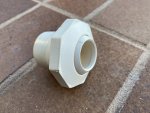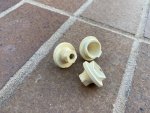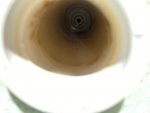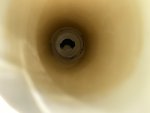My pool has some eyeball jet fittings that need to be replaced. Some have completely come off leaving behind a bare exposed wide open PVC pipe end while others have broken off in parts and partially remain attached to the pipes. The pool is about 10 years old, is in ground, and is concrete (diamond brite). I cant really tell how these fittings were originally installed but I'd like to know what exactly is involved. I'm sure that the pool was empty when they were first put in and I'm wondering if I'm going to have to lower the water below the returns to do this or if there's some 'shortcut' for doing this underwater? Also, what would be the best / recommended way to remove the old eyeball fittings if they are still partially (or even completely) in place? Perhaps if I'm going to replace a few, I might as well replace them all.
Need help - how to replace / remove eyeball jet fittings
- Thread starter niceguymr
- Start date
You are using an out of date browser. It may not display this or other websites correctly.
You should upgrade or use an alternative browser.
You should upgrade or use an alternative browser.
Re: Need help - how to replace eyeball jet fittings
Shameless bump for the weekday crew
Shameless bump for the weekday crew
Re: eyeball removal tool?
I'm bumping this thread to see if anyone has any good updates on an effective removal tool.
My pool is about 10+ years old and the eyeball fitting seems drying/cracking in small parts but not completely coming apart. As a result, the eyeball portion itself is easily removable by hand but the fitting that goes into the pipe remains good and stuck. And the fitting doesn't protrude out far enough from the wall to get any kind of grip on it to twist or turn it - it's almost flush against the wall of the pool. So I'm really kind of stuck trying to figure out how to remove these so I can replace the ones that need replacing.
I'm bumping this thread to see if anyone has any good updates on an effective removal tool.
My pool is about 10+ years old and the eyeball fitting seems drying/cracking in small parts but not completely coming apart. As a result, the eyeball portion itself is easily removable by hand but the fitting that goes into the pipe remains good and stuck. And the fitting doesn't protrude out far enough from the wall to get any kind of grip on it to twist or turn it - it's almost flush against the wall of the pool. So I'm really kind of stuck trying to figure out how to remove these so I can replace the ones that need replacing.
It is difficult to answer your questions without some much more specific information. Some photos would help.
There is normally a threaded fitting embedded in the plaster and then something screwed into that. If so, all you need to do is unscrew what is left of the part that used to be screwed in. If something more complex than that is going on, I can't imagine what it is without more information.
There is normally a threaded fitting embedded in the plaster and then something screwed into that. If so, all you need to do is unscrew what is left of the part that used to be screwed in. If something more complex than that is going on, I can't imagine what it is without more information.
JasonLion said:It is difficult to answer your questions without some much more specific information. Some photos would help.
There is normally a threaded fitting embedded in the plaster and then something screwed into that. If so, all you need to do is unscrew what is left of the part that used to be screwed in. If something more complex than that is going on, I can't imagine what it is without more information.
I posted about it in another topic to try and better describe it like this...
My pool is about 10+ years old and the eyeball fitting seems to be drying/cracking in small parts but not completely coming apart. As a result, only the eyeball portion itself is easily removable by hand but the actual fitting that holds the eyeball goes into the pipe remains good and stuck. And the fitting doesn't protrude out far enough from the wall to get any kind of grip on it to twist or turn it - it's almost flush against the wall of the pool. As a result, I don't have any way to get my hand around the fitting. So I'm really kind of stuck trying to figure out how to remove these so I can replace the ones that need replacing.
There should be two groves in the threaded fitting on the inside. You should be able to find something that is the right size to engage those two groves, for example a paint stirring stick or a ruler, and use that to unscrew the remaining part. You can also buy a special tool, specifically designed to unscrew that part, but it generally isn't worth the money unless you do this every day.
Re: eyeball removal tool?
Once you get it out, make sure to use teflon tape when you put it back in/replace it, and for heavens sake, don't put it in tightly! It just holds the eyeball in, and you can leave it out if you want to reduce the pump pressure.
Good Luck, and Best Wishes!
Go to a Pool Store and ask for a return fitting. Look at how they are put together, there should be three pieces, the outer eye ball cap, the eyeball, and the inner holder. The inner holder is threaded at both ends, the eye ball end has a beveled lip/edge where the eye ball goes and the cap screws on. The other end has male pipe threads that screw into your return pipe. Now look inside of the fitting opening, there should be two grooves, each about 1/8 of an inch deep on opposite sides of the inner surface. You need to find something that will slide into the fitting and engage those grooves, allowing you to remove the fitting. I have seen a metal T wrench used, you can try a wooden paint stirrer, but if it is really stuck the wood will break. I have used a pair of needle nosed pliers before, pulling the handles apart to force the jaws out into the slots while twisting them, but you risk damaging the fitting, and rusting the pliers.eyeball portion itself is easily removable by hand but the fitting that goes into the pipe remains good and stuck
Once you get it out, make sure to use teflon tape when you put it back in/replace it, and for heavens sake, don't put it in tightly! It just holds the eyeball in, and you can leave it out if you want to reduce the pump pressure.
Good Luck, and Best Wishes!
niceguy, you probably have insider fittings that slip inside the imbedded inlets. These are usually hammered into the pipe and held in place by friction. The best way to remove them is by prying them out with a flat head screwdriver slowly working around the perimeter of the fitting.
- Jun 12, 2011
- 3,761
- Pool Size
- 19500
- Surface
- Plaster
- Chlorine
- Salt Water Generator
- SWG Type
- Pureline Crystal Pure 60,000
I have a wood chisel that is just the right size to fit the grooves in my fittings. If they are really stiff I slip the chisel in and use a Cresent wrench to turn it.
dabg
Member
I just removed my return fitting which are slip-in style as shown in the first picture. After some search I found the replacement parts: Inlet, Eyeball Ftg 1 1/2" Slip Eq (542002) - INYOPools.com.
Within the pipe inside this return fitting, I also found broken Ventura tee (explained here) like parts as shown in the second picture. It has a small mouth plus two tabs in the back of the mouse to hold it within the pipe, see picture 3 for Any one know how to replace it? Thanks in advance!



Within the pipe inside this return fitting, I also found broken Ventura tee (explained here) like parts as shown in the second picture. It has a small mouth plus two tabs in the back of the mouse to hold it within the pipe, see picture 3 for Any one know how to replace it? Thanks in advance!




Last edited:
Thread Status
Hello , This thread has been inactive for over 60 days. New postings here are unlikely to be seen or responded to by other members. For better visibility, consider Starting A New Thread.


